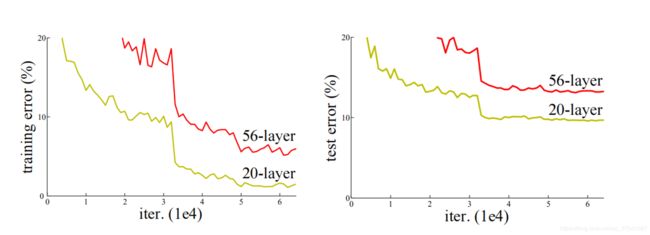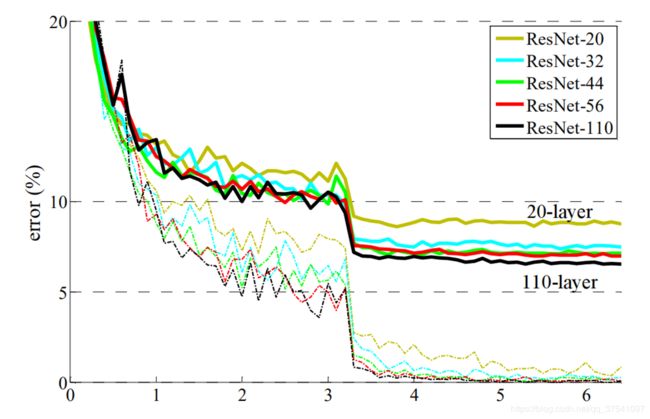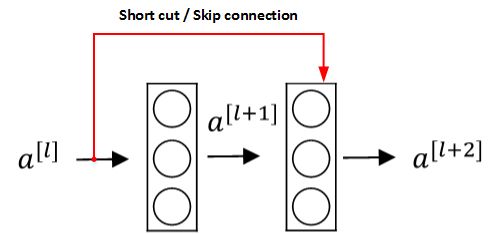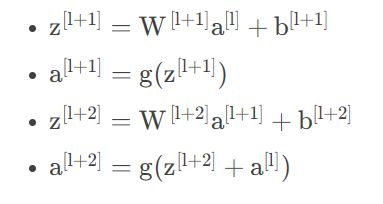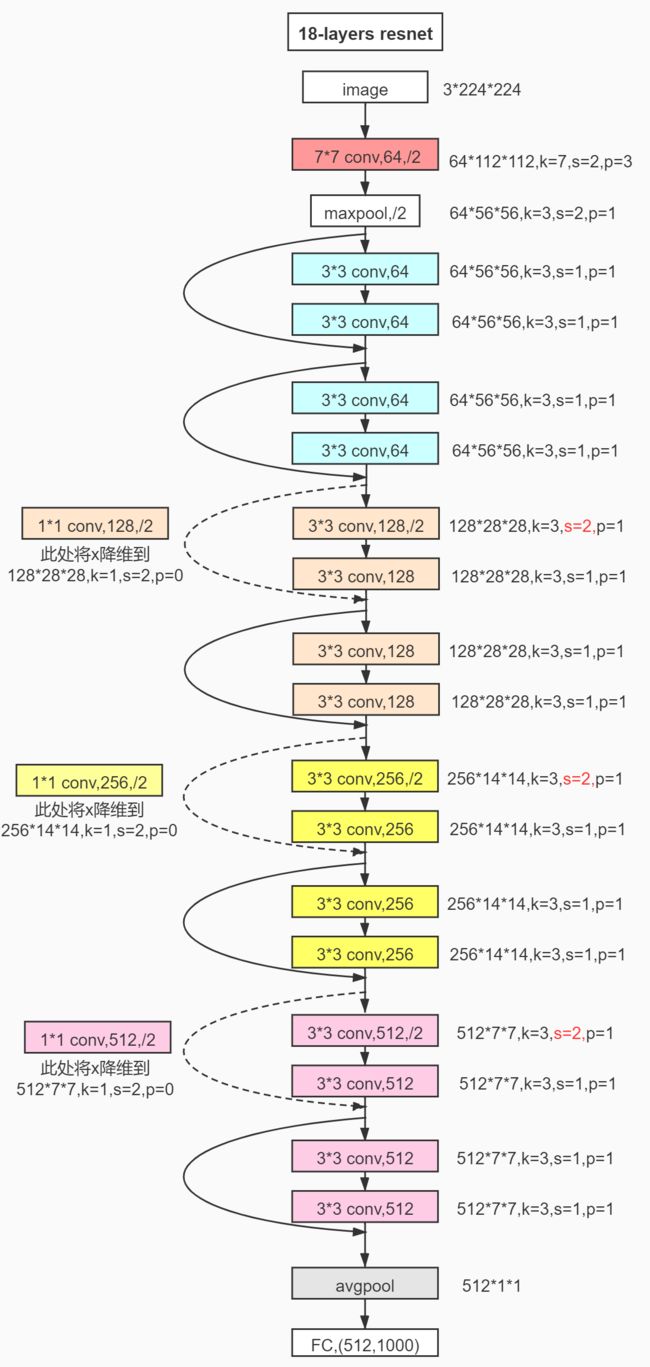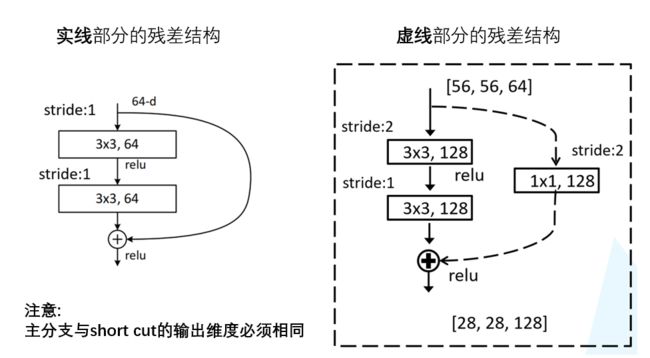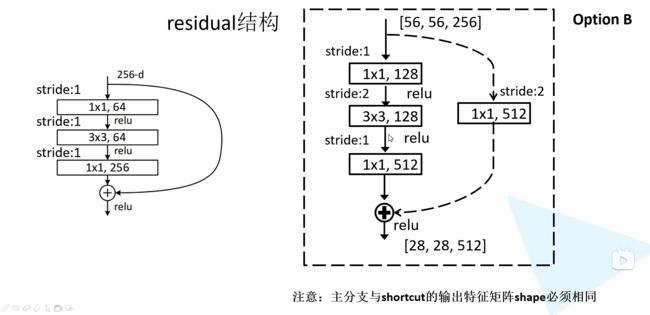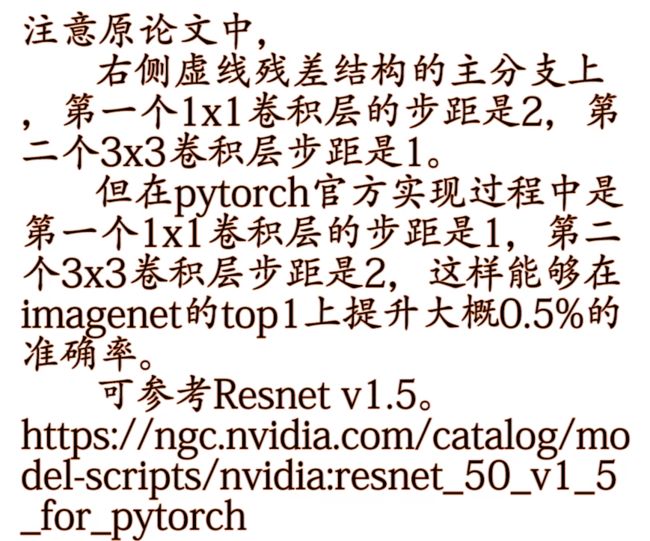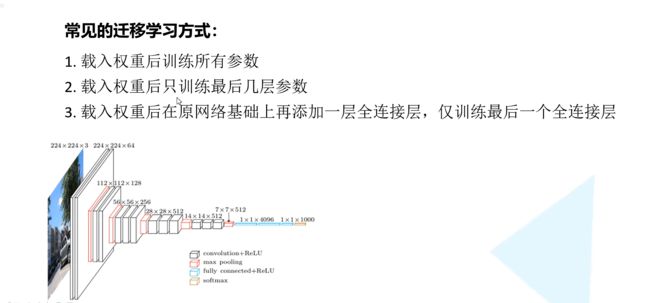6.1 ResNet网络结构 BN及迁移学习
1.ResNet详解
ResNet 网络是在 2015年 由微软实验室提出,斩获当年ImageNet竞赛中分类任务第一名,目标检测第一名。获得COCO数据集中目标检测第一名,图像分割第一名。
ResNet网络中的两点:
提出 Residual 结构(残差结构),并搭建超深的网络结构(可突破1000层)
使用 Batch Normalization 加速训练(丢弃dropout)
1.1 Why residual?
在ResNet网络提出之前,传统的卷积神经网络都是通过将一系列卷积层与池化层进行堆叠得到的。
一般我们会觉得网络越深,特征信息越丰富,模型效果应该越好。但是实验证明,当网络堆叠到一定深度时,会出现两个问题:
梯度消失或梯度爆炸
假设每一层的误差梯度小于1,每向前传播一层,都要乘以一个小于1的误差梯度,网络越深时,梯度越趋近于0 ——梯度消失
反之,若每一层的误差梯度大于1,反向传播时,网路越深,梯度越来越大 ——梯度爆炸
解决梯度消失和梯度爆炸的一般方案:1、对于数据进行标准化处理 2、权重初始化 3、ResNet论文提出通过数据的预处理以及在网络中使用 BN(Batch Normalization)层来解决。
退化问题(degradation problem):在解决了梯度消失、爆炸问题后,仍然存在深层网络的效果可能比浅层网络差的现象
总结就是,当网络堆叠到一定深度时,反而会出现深层网络比浅层网络效果差的情况。
如下图所示,20层网络 反而比 56层网络 的误差更小:
对于退化问题,ResNet论文提出了 residual结构(残差结构)来减轻退化问题,下图是使用residual结构的卷积网络,可见随着网络层数的不断加深,效果并没有变差,而是变的更好。(虚线是训练集错误率,实线是验证集错误率)
1.2 residual结构
1.什么是residual
为了解决深层网络中的退化问题,可以人为地让神经网络某些层跳过下一层神经元的连接,隔层相连,弱化每层之间的强联系。这种神经网络被称为 残差网络 (ResNets)。
残差网络由许多隔层相连的神经元子模块组成,我们称之为 残差块 Residual block。单个残差块的结构如下图所示:
上图中红色部分称为 short cut 或者 skip connection(也称 捷径分支),直接建立
a[l] 与 a[l+2] 之间的隔层联系。其前向传播的计算步骤为:
a[l] 直接隔层与下一层的线性输出相连,与 z[l+2] 共同通过激活函数(ReLU)输出 a[l+2]。
由多个 残差块 组成的神经网络就是 残差网络 。其结构如下图所示:
实验表明,这种模型结构对于训练非常深的神经网络,效果很好。
为了便于区分,我们把 非残差网络 称为 Plain Network。
2.ResNet中的残差结构
实际应用中,残差结构的 short cut 不一定是隔一层连接,也可以中间隔多层,ResNet所提出的残差网络中就是隔多层。
跟VggNet类似,ResNet也有多个不同层的版本,而残差结构也有两种对应浅层和深层网络:
ResNet |
残差结构 |
|
浅层网络 |
ResNet18/34 |
BasicBlock |
深层网络 |
ResNet50/101/152 |
Bottleneck |
下图中左侧残差结构称为 BasicBlock,右侧残差结构称为 Bottleneck
对于深层的 Bottleneck,1×1的卷积核起到降维和升维(特征矩阵深度)的作用,同时可以大大减少网络参数。
假设两个残差结构的输入特征和输出特征矩阵的深度都是256维,如下图:
那么两个残差结构所需的参数为:
左侧:3 × 3 × 256 × 256 + 3 × 3 × 256 × 256 = 1 , 179 , 648
右侧:1 × 1 × 256 × 64 + 3 × 3 × 64 × 64 + 1 × 1 × 64 × 256 = 69 , 632
注:CNN参数个数 = 卷积核尺寸×卷积核深度 × 卷积核组数 = 卷积核尺寸 × 输入特征矩阵深度 × 输出特征矩阵深度
明显搭建深层网络时,使用右侧的残差结构更合适。
3.降维时的short cut
ResNet18层网络,可以发现有些残差块的 short cut 是实线的,而有些则是虚线的。
这些虚线的 short cut 上通过1×1的卷积核进行了维度处理(特征矩阵在长宽方向降采样,深度方向调整成下一层残差结构所需要的channel)。
下图是原论文给出的不同深度的ResNet网络结构配置,注意表中的残差结构给出了主分支上卷积核的大小与卷积核个数,表中 残差块×N 表示将该残差结构重复N次。
conv3_x, conv4_x, conv5_x所对应的一系列残差结构的第一层残差结构都是虚线残差结构。因为这一系列残差结构的第一层都有调整输入特征矩阵shape的使命(将特征矩阵的高和宽缩减为原来的一半,将深度channel调整成下一层残差结构所需要的channel)
对于ResNet18/34, conv2_x所对应的残差结构的第一层是实线残差结构, 通过最大池化下采样后得到的输出是[56, 56, 64],刚好是实线残差结构所需要的输入shape。
对于ResNet50/101/152,其实conv2_x所对应的一系列残差结构的第一层也是虚线残差结构,因为它需要调整输入特征矩阵的channel。根据表格可知通过3x3的max pool之后输出的特征矩阵shape应该是[56, 56, 64],但conv2_x所对应的一系列残差结构中的实线残差结构它们期望的输入特征矩阵shape是[56, 56, 256](因为这样才能保证输入输出特征矩阵shape相同,才能将捷径分支的输出与主分支的输出进行相加)。所以第一层残差结构需要将shape从[56, 56, 64] --> [56, 56, 256]。注意,这里只调整channel维度,高和宽不变(而conv3_x, conv4_x, conv5_x所对应的一系列残差结构的第一层虚线残差结构不仅要调整channel还要将高和宽缩减为原来的一半)。
ResNet 18/34 和 ResNet 50/101/152 具体的实线/虚线残差结构图:
ResNet 18/34
输入特征矩阵shape是[56, 56, 64]
输出特征矩阵shape是[28, 28, 128]
ResNet 50/101/152s
输入特征矩阵shape是[56, 56, 256]
输出特征矩阵shape是[28, 28, 512]
2.Batch Normalizaton
Batch Normalization详解以及pytorch实验
3.迁移学习
使用迁移学习的优势:
能够快速的训练出一个理想的结果
当数据集较小时也能训练出理想的效果
注意:使用别人预训练好的模型参数时,要注意别人的预处理方式。
在迁移学习中,我们希望利用源任务(Source Task)学到的知识帮助学习目标任务 (Target Task)。例如,一个训练好的图像分类网络能够被用于另一个图像相关的任务。再比如,一个网络在仿真环境学习的知识可以被迁移到真实环境的网络。迁移学习一个典型的例子就是载入训练好VGG网络,这个大规模分类网络能将图像分到1000个类别,然后把这个网络用于另一个任务,如医学图像分类。
为什么可以这么做呢?如下图所示,神经网络逐层提取图像的深层信息,这样,预训练网络就相当于一个特征提取器。
4.Pytorch搭建ResNet
4.1 model.py
定义ResNet18/34的残差结构,即BasicBlock
定义ResNet50/101/152的残差结构,即Bottleneck
定义ResNet网络结构
定义resnet18/34/50/101/152
import torch.nn as nn
import torch
# ResNet18/34的残差结构,用的是2个3x3的卷积
class BasicBlock(nn.Module):
expansion = 1 # 残差结构中,主分支的卷积核个数是否发生变化,不变则为1
def __init__(self, in_channel, out_channel, stride=1, downsample=None): # downsample对应虚线残差结构
super(BasicBlock, self).__init__()
self.conv1 = nn.Conv2d(in_channels=in_channel, out_channels=out_channel,
kernel_size=3, stride=stride, padding=1, bias=False)
self.bn1 = nn.BatchNorm2d(out_channel)
self.relu = nn.ReLU()
self.conv2 = nn.Conv2d(in_channels=out_channel, out_channels=out_channel,
kernel_size=3, stride=1, padding=1, bias=False)
self.bn2 = nn.BatchNorm2d(out_channel)
self.downsample = downsample
def forward(self, x):
identity = x
if self.downsample is not None: # 虚线残差结构,需要下采样
identity = self.downsample(x) # 捷径分支 short cut
out = self.conv1(x)
out = self.bn1(out)
out = self.relu(out)
out = self.conv2(out)
out = self.bn2(out)
out += identity
out = self.relu(out)
return out
# ResNet50/101/152的残差结构,用的是1x1+3x3+1x1的卷积
class Bottleneck(nn.Module):
expansion = 4 # 残差结构中第三层卷积核个数是第一/二层卷积核个数的4倍
def __init__(self, in_channel, out_channel, stride=1, downsample=None):
super(Bottleneck, self).__init__()
self.conv1 = nn.Conv2d(in_channels=in_channel, out_channels=out_channel,
kernel_size=1, stride=1, bias=False) # squeeze channels
self.bn1 = nn.BatchNorm2d(out_channel)
# -----------------------------------------
self.conv2 = nn.Conv2d(in_channels=out_channel, out_channels=out_channel,
kernel_size=3, stride=stride, bias=False, padding=1)
self.bn2 = nn.BatchNorm2d(out_channel)
# -----------------------------------------
self.conv3 = nn.Conv2d(in_channels=out_channel, out_channels=out_channel * self.expansion,
kernel_size=1, stride=1, bias=False) # unsqueeze channels
self.bn3 = nn.BatchNorm2d(out_channel * self.expansion)
self.relu = nn.ReLU(inplace=True)
self.downsample = downsample
def forward(self, x):
identity = x
if self.downsample is not None:
identity = self.downsample(x) # 捷径分支 short cut
out = self.conv1(x)
out = self.bn1(out)
out = self.relu(out)
out = self.conv2(out)
out = self.bn2(out)
out = self.relu(out)
out = self.conv3(out)
out = self.bn3(out)
out += identity
out = self.relu(out)
return out
class ResNet(nn.Module):
# block = BasicBlock or Bottleneck
# block_num为残差结构中conv2_x~conv5_x中残差块个数,是一个列表
def __init__(self, block, blocks_num, num_classes=1000, include_top=True):
super(ResNet, self).__init__()
self.include_top = include_top
self.in_channel = 64
self.conv1 = nn.Conv2d(3, self.in_channel, kernel_size=7, stride=2,
padding=3, bias=False)
self.bn1 = nn.BatchNorm2d(self.in_channel)
self.relu = nn.ReLU(inplace=True)
self.maxpool = nn.MaxPool2d(kernel_size=3, stride=2, padding=1)
self.layer1 = self._make_layer(block, 64, blocks_num[0]) # conv2_x
self.layer2 = self._make_layer(block, 128, blocks_num[1], stride=2) # conv3_x
self.layer3 = self._make_layer(block, 256, blocks_num[2], stride=2) # conv4_x
self.layer4 = self._make_layer(block, 512, blocks_num[3], stride=2) # conv5_x
if self.include_top:
self.avgpool = nn.AdaptiveAvgPool2d((1, 1)) # output size = (1, 1)
self.fc = nn.Linear(512 * block.expansion, num_classes)
for m in self.modules():
if isinstance(m, nn.Conv2d):
nn.init.kaiming_normal_(m.weight, mode='fan_out', nonlinearity='relu')
# channel为残差结构中第一层卷积核个数
def _make_layer(self, block, channel, block_num, stride=1):
downsample = None
# ResNet50/101/152的残差结构,block.expansion=4
if stride != 1 or self.in_channel != channel * block.expansion:
downsample = nn.Sequential(
nn.Conv2d(self.in_channel, channel * block.expansion, kernel_size=1, stride=stride, bias=False),
nn.BatchNorm2d(channel * block.expansion))
layers = []
layers.append(block(self.in_channel, channel, downsample=downsample, stride=stride))
self.in_channel = channel * block.expansion
for _ in range(1, block_num):
layers.append(block(self.in_channel, channel))
return nn.Sequential(*layers)
def forward(self, x):
x = self.conv1(x)
x = self.bn1(x)
x = self.relu(x)
x = self.maxpool(x)
x = self.layer1(x)
x = self.layer2(x)
x = self.layer3(x)
x = self.layer4(x)
if self.include_top:
x = self.avgpool(x)
x = torch.flatten(x, 1)
x = self.fc(x)
return x
def resnet34(num_classes=1000, include_top=True):
return ResNet(BasicBlock, [3, 4, 6, 3], num_classes=num_classes, include_top=include_top)
def resnet101(num_classes=1000, include_top=True):
return ResNet(Bottleneck, [3, 4, 23, 3], num_classes=num_classes, include_top=include_top)
4.2 train.py
解读 pytorch对resnet的官方实现
由于ResNet网络较深,直接训练的话会非常耗时,因此用迁移学习的方法导入预训练好的模型参数:
在pycharm中输入import torchvision.models.resnet,ctrl+左键resnet跳转到pytorch官方实现resnet的源码中,下载预训练的模型参数:
model_urls = {
'resnet18': 'https://download.pytorch.org/models/resnet18-5c106cde.pth',
'resnet34': 'https://download.pytorch.org/models/resnet34-333f7ec4.pth',
'resnet50': 'https://download.pytorch.org/models/resnet50-19c8e357.pth',
'resnet101': 'https://download.pytorch.org/models/resnet101-5d3b4d8f.pth',
'resnet152': 'https://download.pytorch.org/models/resnet152-b121ed2d.pth',
'resnext50_32x4d': 'https://download.pytorch.org/models/resnext50_32x4d-7cdf4587.pth',
'resnext101_32x8d': 'https://download.pytorch.org/models/resnext101_32x8d-8ba56ff5.pth',
'wide_resnet50_2': 'https://download.pytorch.org/models/wide_resnet50_2-95faca4d.pth',
'wide_resnet101_2': 'https://download.pytorch.org/models/wide_resnet101_2-32ee1156.pth',
}
然后在实例化网络时导入预训练的模型参数。下面是完整代码:
import torch
import torch.nn as nn
from torchvision import transforms, datasets
import json
import matplotlib.pyplot as plt
import os
import torch.optim as optim
from model import resnet34, resnet101
import torchvision.models.resnet
device = torch.device("cuda:0" if torch.cuda.is_available() else "cpu")
print(device)
data_transform = {
"train": transforms.Compose([transforms.RandomResizedCrop(224),
transforms.RandomHorizontalFlip(),
transforms.ToTensor(),
transforms.Normalize([0.485, 0.456, 0.406], [0.229, 0.224, 0.225])]),
"val": transforms.Compose([transforms.Resize(256),
transforms.CenterCrop(224),
transforms.ToTensor(),
transforms.Normalize([0.485, 0.456, 0.406], [0.229, 0.224, 0.225])])}
data_root = os.path.abspath(os.path.join(os.getcwd(), "../..")) # get data root path
image_path = data_root + "/data_set/flower_data/" # flower data set path
train_dataset = datasets.ImageFolder(root=image_path+"train",
transform=data_transform["train"])
train_num = len(train_dataset)
# {'daisy':0, 'dandelion':1, 'roses':2, 'sunflower':3, 'tulips':4}
flower_list = train_dataset.class_to_idx
cla_dict = dict((val, key) for key, val in flower_list.items())
# write dict into json file
json_str = json.dumps(cla_dict, indent=4)
with open('class_indices.json', 'w') as json_file:
json_file.write(json_str)
batch_size = 16
train_loader = torch.utils.data.DataLoader(train_dataset,
batch_size=batch_size, shuffle=True,
num_workers=0)
validate_dataset = datasets.ImageFolder(root=image_path + "val",
transform=data_transform["val"])
val_num = len(validate_dataset)
validate_loader = torch.utils.data.DataLoader(validate_dataset,
batch_size=batch_size, shuffle=False,
num_workers=0)
net = resnet34()
# load pretrain weights
model_weight_path = "./resnet34-pre.pth"
missing_keys, unexpected_keys = net.load_state_dict(torch.load(model_weight_path), strict=False)
# for param in net.parameters():
# param.requires_grad = False
# change fc layer structure
inchannel = net.fc.in_features
net.fc = nn.Linear(inchannel, 5)
net.to(device)
loss_function = nn.CrossEntropyLoss()
optimizer = optim.Adam(net.parameters(), lr=0.0001)
best_acc = 0.0
save_path = './resNet34.pth'
for epoch in range(3):
# train
net.train()
running_loss = 0.0
for step, data in enumerate(train_loader, start=0):
images, labels = data
optimizer.zero_grad()
logits = net(images.to(device))
loss = loss_function(logits, labels.to(device))
loss.backward()
optimizer.step()
# print statistics
running_loss += loss.item()
# print train process
rate = (step+1)/len(train_loader)
a = "*" * int(rate * 50)
b = "." * int((1 - rate) * 50)
print("\rtrain loss: {:^3.0f}%[{}->{}]{:.4f}".format(int(rate*100), a, b, loss), end="")
print()
# validate
net.eval()
acc = 0.0 # accumulate accurate number / epoch
with torch.no_grad():
for val_data in validate_loader:
val_images, val_labels = val_data
outputs = net(val_images.to(device)) # eval model only have last output layer
# loss = loss_function(outputs, test_labels)
predict_y = torch.max(outputs, dim=1)[1]
acc += (predict_y == val_labels.to(device)).sum().item()
val_accurate = acc / val_num
if val_accurate > best_acc:
best_acc = val_accurate
torch.save(net.state_dict(), save_path)
print('[epoch %d] train_loss: %.3f test_accuracy: %.3f' %
(epoch + 1, running_loss / step, val_accurate))
print('Finished Training')
4.3 predict.py
import torch
from model import resnet34
from PIL import Image
from torchvision import transforms
import matplotlib.pyplot as plt
import json
data_transform = transforms.Compose(
[transforms.Resize(256),
transforms.CenterCrop(224),
transforms.ToTensor(),
transforms.Normalize([0.485, 0.456, 0.406], [0.229, 0.224, 0.225])])
# load image
img = Image.open("../tulip.jpg")
plt.imshow(img)
# [N, C, H, W]
img = data_transform(img)
# expand batch dimension
img = torch.unsqueeze(img, dim=0)
# read class_indict
try:
json_file = open('./class_indices.json', 'r')
class_indict = json.load(json_file)
except Exception as e:
print(e)
exit(-1)
# create model
model = resnet34(num_classes=5)
# load model weights
model_weight_path = "./resNet34.pth"
model.load_state_dict(torch.load(model_weight_path))
model.eval()
with torch.no_grad():
# predict class
output = torch.squeeze(model(img))
predict = torch.softmax(output, dim=0)
predict_cla = torch.argmax(predict).numpy()
print(class_indict[str(predict_cla)], predict[predict_cla].numpy())
plt.show()
